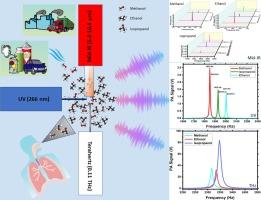A comparative study and trace- level detection of volatile organic biomarkers using UV-IR-THz sources based high −Q helmholtz photoacoustic sensor
IF 4.3
2区 化学
Q1 SPECTROSCOPY
Spectrochimica Acta Part A: Molecular and Biomolecular Spectroscopy
Pub Date : 2024-10-28
DOI:10.1016/j.saa.2024.125332
引用次数: 0
Abstract
This paper reports the trace-level detection of volatile organic compounds (VOCs) like methanol, ethanol, and isopropanol, which are biomarkers for various diseases like diabetes, breast cancer, lung cancer, chronic pulmonary diseases, squamous cancer, cystic fibrosis, chronic liver diseases, chronic kidney diseases and so on. Here, the photoacoustic spectroscopy technique was used for the trace-level detection of these biomarkers using an indigenously designed tunable frequency (1.4 to 4 kHz range) Helmholtz photoacoustic (PA) cell. The study was carried out with UV (266 nm), Mid IR (5.4–7.3 µm) and THz (0.11 THz) range sources to explore and compare the PA signal generated by mentioned samples for different electronic vibrational and rotational level excitations. We achieved a low detection limit (LoD) of the order of 39.3 ppbV, 29.7 ppbV, and 11.6 ppbV for methanol, ethanol, and isopropanol, respectively using this non-invasive cost-effective, and fast technique. In addition, THz-based PA signal for these samples is reported for the first time.

使用基于紫外-红外-THz 源的高-Q Helmholtz 光声传感器对挥发性有机生物标记物进行比较研究和痕量检测
本文报道了甲醇、乙醇和异丙醇等挥发性有机化合物(VOCs)的痕量检测,这些物质是糖尿病、乳腺癌、肺癌、慢性肺病、鳞癌、囊性纤维化、慢性肝病、慢性肾病等多种疾病的生物标记物。在此,利用自主设计的可调频率(1.4 至 4 kHz 范围)亥姆霍兹光声(PA)电池,采用光声光谱技术对这些生物标记物进行痕量检测。研究使用紫外(266 纳米)、中红外(5.4-7.3 微米)和太赫兹(0.11 太赫兹)范围的光源,以探索和比较上述样品在不同电子振动和旋转水平激发下产生的 PA 信号。利用这种非侵入式、成本效益高且快速的技术,我们对甲醇、乙醇和异丙醇分别实现了 39.3 ppbV、29.7 ppbV 和 11.6 ppbV 的低检测限 (LoD)。此外,还首次报告了这些样品的太赫兹功率放大器信号。
本文章由计算机程序翻译,如有差异,请以英文原文为准。
求助全文
约1分钟内获得全文
求助全文
来源期刊
CiteScore
8.40
自引率
11.40%
发文量
1364
审稿时长
40 days
期刊介绍:
Spectrochimica Acta, Part A: Molecular and Biomolecular Spectroscopy (SAA) is an interdisciplinary journal which spans from basic to applied aspects of optical spectroscopy in chemistry, medicine, biology, and materials science.
The journal publishes original scientific papers that feature high-quality spectroscopic data and analysis. From the broad range of optical spectroscopies, the emphasis is on electronic, vibrational or rotational spectra of molecules, rather than on spectroscopy based on magnetic moments.
Criteria for publication in SAA are novelty, uniqueness, and outstanding quality. Routine applications of spectroscopic techniques and computational methods are not appropriate.
Topics of particular interest of Spectrochimica Acta Part A include, but are not limited to:
Spectroscopy and dynamics of bioanalytical, biomedical, environmental, and atmospheric sciences,
Novel experimental techniques or instrumentation for molecular spectroscopy,
Novel theoretical and computational methods,
Novel applications in photochemistry and photobiology,
Novel interpretational approaches as well as advances in data analysis based on electronic or vibrational spectroscopy.

 求助内容:
求助内容: 应助结果提醒方式:
应助结果提醒方式:


